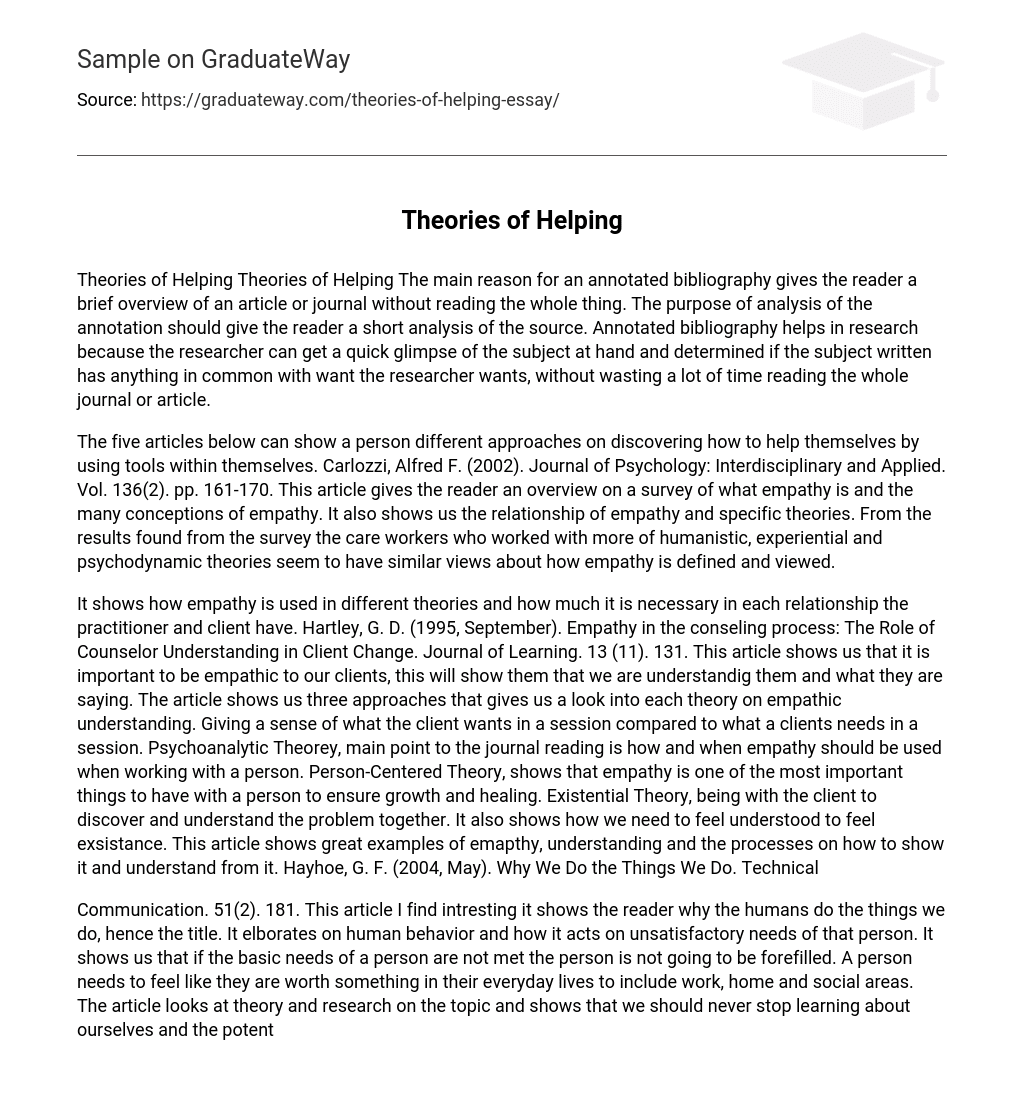The five articles below can show a person different approaches on discovering how to help themselves by using tools within themselves.
Carlozzi, Alfred F. (2002). Journal of Psychology. Interdisciplinary and Applied. Vol. 136(2). pp. 161-170. This article gives the reader an overview on a survey of what empathy is and the many conceptions of empathy. It also shows us the relationship of empathy and specific theories. From the results found from the survey the care workers who worked with more of humanistic, experiential and psychodynamic theories seem to have similar views about how empathy is defined and viewed. It shows how empathy is used in different theories and how much it is necessary in each relationship the practitioner and client have.
Hartley, G. D. (1995, September) Empathy in the conseling process: The Role of Counselor Understanding in Client Change. Journal of Learning. 13 (11). 131. This article shows us that it is important to be empathic to our clients, this will show them that we are understandig them and what they are saying. The article shows us three approaches that gives us a look into each theory on empathic understanding. Giving a sense of what the client wants in a session compared to what a clients needs in a session.
Psychoanalytic Theorey, main point to the journal reading is how and when empathy should be used when working with a person. Person-Centered Theory, shows that empathy is one of the most important things to have with a person to ensure growth and healing. Existential Theory, being with the client to discover and understand the problem together. It also shows how we need to feel understood to feel exsistance. This article shows great examples of emapthy, understanding and the processes on how to show it and understand from it.
Hayhoe, G. F. (2004, May). Why We Do the Things We Do. Technical Communication. 51(2). 181. This article I find intresting it shows the reader why the humans do the things we do, hence the title. It elborates on human behavior and how it acts on unsatisfactory needs of that person. It shows us that if the basic needs of a person are not met the person is not going to be forefilled. A person needs to feel like they are worth something in their everyday lives to include work, home and social areas. The article looks at theory and research on the topic and shows that we should never stop learning about ourselves and the potential that we with hold in each of us.
McBrien, R. (2004). Expanding Social Intrerest Through Forgiveness. Journal of Psychoanalysis , 16(2). 171. This is a great article on showing how forgiveness gives us inner peace no matter what the situation is. Forgiveness is a therapeutic intervention to help a person overcome the situation and have growth in the inner body and mind. It explores the spirituality of forgiveness and how it connects and makes us who we are today. Connects empathy to the basis of forgiveness and shows the reader without having empathy for the person who hurt us we are not truly forgiving them. Without experiencing these behaviors we cannot heal ourselves fully and be at our full potential.
Moore, L. (2006). Emapthy: A Clinician’s Perspective. A S H A Leader , p16(4). This article gives a point of view of empathy from the clinician on how empathy impacts the client and what they might experience in an office visit that might show the lack of empathy. The article brought to light things I wouldn’t have thought of that might take away from the session. It goes over the study and origins of empathy and how some think it should not be part of a therapeutic relationship.
The article also gives multiple examples of how neuroscientists are studying parts of the brain to discover how empathy impacts the mind. The five articles chosen really show different opinions and views on what empathy is and how it should be shown. I think the a annotated bibliography gives a good insight into a particular subject but the draw back to it is that everyone takes what they want from each thing that they read. Over all, though it can be useful in getting a quick look at many articles without spending a lot of time reading the whole thing.
Bibliography
- Carlozzi, A. (2002). Interdisciplinary and Applied. Journal of Psychology , 161-170.
- Hartley, G. D. (1995). Empathy in the Conseling Process: The Role of Counselor Understanding in Client Change. Journal of learning , 13(11). 131.
- Hayhoe, G. F. (2004, May). Why We Do the Things We Do. Technical Communication. 51(2). 181.
- McBrien, R. (2004). Expanding Social Intrerest Through Forgiveness. Journal of Psychoanalysis , 16(2). 171.
- Moore, L. (2006). Emapthy: A Clinician’s Perspective. A S H A Leader , p16(4).





